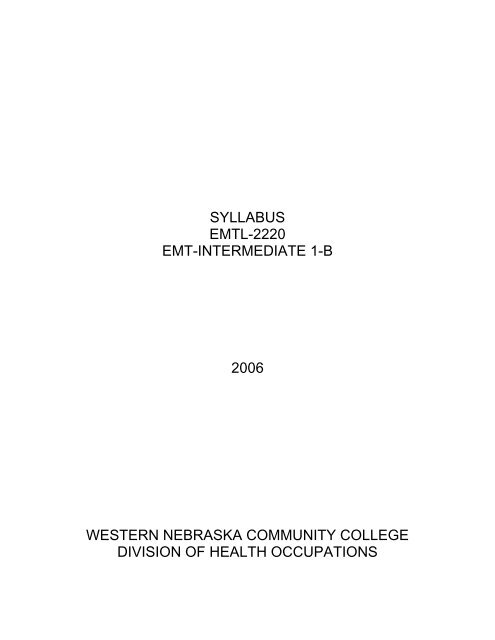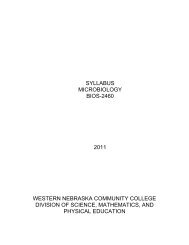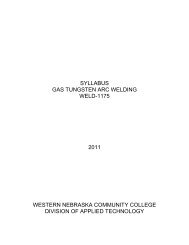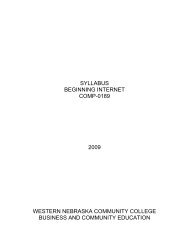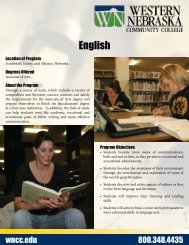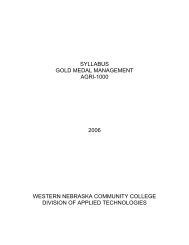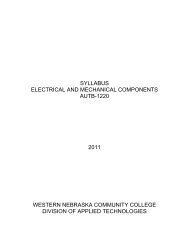View Current Syllabus - Western Nebraska Community College
View Current Syllabus - Western Nebraska Community College
View Current Syllabus - Western Nebraska Community College
You also want an ePaper? Increase the reach of your titles
YUMPU automatically turns print PDFs into web optimized ePapers that Google loves.
SYLLABUS<br />
EMTL-2220<br />
EMT-INTERMEDIATE 1-B<br />
2006<br />
WESTERN NEBRASKA COMMUNITY COLLEGE<br />
DIVISION OF HEALTH OCCUPATIONS
I. CATALOG DESCRIPTION:<br />
EMTL-2220<br />
EMT-Intermediate 1-B<br />
Prerequisite: EMTL-2210 EMT-Intermediate 1-A<br />
This course is a continuation of EMT-Intermediate 1-A. Topics include<br />
intubation, airway management, trauma emergencies, and behavioral<br />
emergencies. Students will utilize concepts and skills learned in EMT-<br />
Intermediate 1-A throughout this course.<br />
(8/75/0/135/0/V)<br />
II.<br />
GENERAL OBJECTIVES:<br />
A. Prepare Emergency Medical Technicians at the Intermediate level to handle<br />
trauma emergencies<br />
B. Complete a thorough primary and secondary assessment and explain the<br />
normal and abnormal findings that could be identified in patients with trauma<br />
emergencies<br />
C. Prepare Emergency Medical Technicians at the Intermediate level to handle<br />
behavioral emergencies<br />
D. Complete a thorough primary and secondary assessment and explain the<br />
normal and abnormal findings that could be identified inpatients with<br />
behavioral emergencies<br />
E. Provide the appropriate support for patients, family, self and other co-workers<br />
in the event of a stressful situation and/or death<br />
III.<br />
INSTRUCTIONAL MATERIALS:<br />
A. Required Text:<br />
1. Shade, B.R., Rothenberg, M., Wertz, E., Jones, S., & Collins, T.; Mosby’s<br />
EMT-Intermediate Textbook; Mosby; Latest Edition<br />
IV.<br />
COURSE OUTLINE:<br />
A. Unit I: Airway Management<br />
B. Unit II: Trauma Emergencies<br />
C. Unit III: Behavioral Emergencies
V. METHODS OF PRESENTATION:<br />
EMT-INTERMEDIATE 1-B<br />
EMTL-2220<br />
A. Lecture<br />
B. Discussion<br />
C. Role-play<br />
D. Simulated practice sessions<br />
E. Video presentations<br />
F. Demonstration<br />
G. Clinical/Field Experiences<br />
VI.<br />
METHODS OF EVALUATION:<br />
A. Exams (Quizzes, Unit Exams, Final)<br />
B. Written Assignments/Presentation<br />
C. Skills Competencies<br />
D. Clinical/Field Experiences<br />
VII.<br />
SPECIFIC OBJECTIVES:<br />
A. Unit I: Airway Management<br />
Upon the completion of this unit, the student will:<br />
Behavioral Objectives<br />
1. Explain the primary objective of airway<br />
maintenance.<br />
2. Identify commonly neglected<br />
prehospital skills related to airway.<br />
3. Identify the anatomy of the upper and<br />
lower airway.<br />
4. Describe the functions of the upper and<br />
lower airway.<br />
5. Explain the difference between adult<br />
and pediatric airway anatomy.<br />
6. Define gag reflex.<br />
7. Explain the relationship between<br />
pulmonary circulation and respiration.<br />
Skills Lab Objective<br />
Perform body substance isolation (BSI)<br />
procedure during basic and advanced<br />
airway management, and ventilation.<br />
2
EMT-INTERMEDIATE 1-B<br />
EMTL-2220<br />
Behavioral Objectives<br />
Skills Lab Objective<br />
8. List the concentration of gases which<br />
comprise air.<br />
9. Describe the measure of oxygen in the<br />
blood.<br />
10. Describe the measurement of carbon Perform end-tidal CO 2 detection.<br />
dioxide in the blood.<br />
11. Describe peak expiratory flow. Perform peak expiratory flow testing.<br />
12. List factors which cause decreased<br />
oxygen concentration in the blood.<br />
13. List the factors which increase and<br />
decrease carbon dioxide production in the<br />
body.<br />
14. Define atelectasis.<br />
15. Define FiO 2 .<br />
16. Define and differentiate between<br />
hypoxia and hypoxemia.<br />
17. Describe the voluntary and involuntary<br />
regulation of respiration.<br />
18. Describe the modified forms of<br />
respiration.<br />
19. Define normal respiratory rates and<br />
tidal volumes for the adult, child and infant.<br />
20. List factors which affect respiratory<br />
rate and depth.<br />
21. Explain the risk of infection of EMS<br />
providers associated with ventilation.<br />
22. Define pulsus paradoxus.<br />
23. Define and explain the implications of<br />
partial airway obstruction with good and<br />
poor air exchange.<br />
24. Define complete airway obstruction.<br />
25. Describe causes of upper airway<br />
obstruction.<br />
26. Describe causes of respiratory<br />
distress.<br />
27. Describe manual airway maneuvers. Perform manual airway maneuvers<br />
including:<br />
a. Opening the mouth<br />
b. Head-tilt/chin-lift maneuver<br />
c. Jaw-thrust without head-tilt maneuver<br />
d. Modified jaw-thrust maneuver<br />
Perform the above manual airway<br />
maneuvers for pediatric patients<br />
28. Describe the Sellick (cricoid) pressure Perform the Sellick maneuver (cricoid<br />
3
EMT-INTERMEDIATE 1-B<br />
EMTL-2220<br />
Behavioral Objectives<br />
maneuver.<br />
29. Describe complete airway obstruction<br />
maneuvers.<br />
30. Explain the purpose for suctioning the<br />
upper airway.<br />
31. Identify types of suction equipment.<br />
32. Describe the indications for suctioning<br />
the upper airway.<br />
33. Identify types of suction catheters,<br />
including hard or rigid catheters and soft<br />
catheters.<br />
34. Identify techniques of suctioning the<br />
upper airway.<br />
35. Identify special considerations of<br />
suctioning the upper airway.<br />
36. Describe the use of an oral and nasal<br />
airway.<br />
37. Describe the use of an oral and nasal<br />
airway.<br />
38. Identify special considerations of<br />
tracheobronchial suctioning in the<br />
intubated patient.<br />
39. Define gastric suctioning.<br />
40. Describe indications,<br />
contraindications, advantages,<br />
disadvantages, complications, equipment<br />
and technique for inserting a nasogastric<br />
tube and orogastric tube.<br />
41. Identify special considerations of<br />
gastric decompression.<br />
42. Describe the indication,<br />
contraindications, advantages,<br />
complications, and techniques for inserting<br />
an oropharyngeal and nasopharyngeal<br />
airway.<br />
43. Describe the indications,<br />
contraindications, advantages,<br />
disadvantages, complications, and<br />
technique for ventilating a patient by:<br />
a. Mouth-to-mouth<br />
Skills Lab Objective<br />
pressure).<br />
Perform complete airway obstruction<br />
maneuvers, including:<br />
a. Heimlich maneuver<br />
b. Finger sweep<br />
c. chest thrusts<br />
d. Removal with Magill forcepts<br />
Demonstrate suctioning the upper airway<br />
by selecting a suction device.<br />
Perform tracheobronchial suctioning in the<br />
intubated patient by selecting a suction<br />
device, catheter and technique.<br />
Demonstrate insertion of a nasogastric<br />
tube.<br />
Perform gastric decompression by<br />
selecting a suction device, catheter, and<br />
techniques.<br />
Demonstrate insertion of an orogastric<br />
tube.<br />
Demonstrate insertion of a<br />
nasopharyngeal airway.<br />
Demonstrate ventilating a patient by the<br />
following techniques:<br />
a. Mouth-to-mouth<br />
b. Mouth-to-nose<br />
c. Mouth-to-mask<br />
4
EMT-INTERMEDIATE 1-B<br />
EMTL-2220<br />
Behavioral Objectives<br />
b. Mouth-to-nose<br />
c. Mouth-to-mask<br />
d. One person bag-valve-mask<br />
e, Two person bag-valve-mask<br />
f. Three person bag-valve-mask<br />
g. Flow-restricted, oxygen-powered<br />
ventilation device<br />
44. Explain the advantage of the two<br />
person method when ventilating with a<br />
bag-valve-mask.<br />
45. Compare the ventilation techniques<br />
used for an adult patient to those used for<br />
pediatric patients.<br />
46. Describe indications,<br />
contraindications, advantages,<br />
disadvantages, complications, and<br />
techniques for ventilating a patient with an<br />
automatic transport ventilator.<br />
47. Explain safety considerations of<br />
oxygen storage and delivery.<br />
48. Identify types of oxygen cylinders and<br />
pressure regulators (including a highpressure<br />
regulator and a therapy<br />
regulator).<br />
49. List the steps for delivering oxygen<br />
from a cylinder and regulator.<br />
50. Describe the use, advantages and<br />
disadvantages of an oxygen humidifier.<br />
51. Describe the indications,<br />
contraindications, advantages,<br />
disadvantages, complications, liter flow<br />
range, and concentration of delivered<br />
oxygen for supplement oxygen devices.<br />
52. Define, identify, and describe a<br />
tracheostomy, stoma, and tracheostomy<br />
tube.<br />
53. Define, identify and describe a<br />
larygectomy.<br />
54. Define how to ventilate a patient with<br />
a stoma, including mouth-to-stoma and<br />
Skills Lab Objective<br />
d. One person bag-valve-mask<br />
e, Two person bag-valve-mask<br />
f. Three person bag-valve-mask<br />
g. Flow-restricted, oxygen-powered<br />
ventilation device<br />
Ventilate a pediatric patient using one and<br />
two person techniques.<br />
Perform ventilation with a bag-valve-mask<br />
with an in-line small-volume nebulizer.<br />
Perform oxygen delivery from a cylinder<br />
and regulator with an oxygen delivery<br />
device.<br />
Perform oxygen delivery with an oxygen<br />
humidifier.<br />
Deliver supplemental oxygen to a<br />
breathing patient using the following<br />
devices:<br />
a, Nasal cannula<br />
b. Simple face mask<br />
c. Partial rebreather mask<br />
d. Non-rebreather mask<br />
e. Venture mask<br />
Perform stoma suctioning.<br />
Perform replacement of a tracheostomy<br />
tube through a stoma.<br />
5
EMT-INTERMEDIATE 1-B<br />
EMTL-2220<br />
Behavioral Objectives<br />
Skills Lab Objective<br />
bag-valve-mask-to-stoma ventilation.<br />
55. Describe the special considerations in<br />
airway management and ventilation for<br />
patients with facial injuries.<br />
56. Describe the special considerations in<br />
airway management and ventilation for the<br />
pediatric patient.<br />
57. Differentiate endotracheal intubation<br />
from other methods of advanced airway<br />
management.<br />
58. Describe the indications,<br />
contraindications, advantages,<br />
disadvantages, and complications of<br />
endotracheal intubation.<br />
59. Describe laryngoscopy for the removal Perform retrieval of foreign bodies from the<br />
of a foreign body airway obstruction. upper airway.<br />
60. Describe the visual landmarks for<br />
direct laryngoscopy.<br />
61. Describe the use of cricoid pressure Intubate the trachea by direct orotracheal<br />
during intubation.<br />
intubation.<br />
62. Describe the indications,<br />
contraindications, advantages,<br />
disadvantages, complications, equipment,<br />
and techniques for using a dual lumen<br />
airway.<br />
63. Describe the methods of assessment Perform assessment to confirm correct<br />
for confirming correct placement of an placement of the endotracheal tube.<br />
endotracheal tube.<br />
64. Describe methods for securing an Adequately secure an endotracheal tube.<br />
endotracheal tube.<br />
65. Describe the indications,<br />
Perform extubation.<br />
contraindications, advantages,<br />
disadvantages, complications, equipment<br />
and technique for extubation.<br />
66. Describe methods of endotracheal Perform endotracheal intubation in the<br />
intubation in the pediatric patient.<br />
pediatric patient.<br />
67. Describe how the laryngeal mask<br />
airway (LMA).<br />
68. Identify patient conditions that indicate<br />
the use of the LMA or similar device.<br />
69. Differentiate the indications and<br />
contraindications where this type of airway<br />
would be utilized versus other airway<br />
management techniques.<br />
70. Discuss the steps for the correct Demonstrate the correct insertion of the<br />
6
Behavioral Objectives<br />
insertion of the LMA.<br />
LMA.<br />
EMT-INTERMEDIATE 1-B<br />
EMTL-2220<br />
Skills Lab Objective<br />
B. Unit II: Trauma Emergencies: Hemorrhage and Shock<br />
Upon completion of Unit II, the student will:<br />
Behavioral Objectives<br />
1. Describe the epidmiology, including<br />
morbidity, mortality and prevention<br />
strategies for shock and hemorrhage.<br />
2. Discuss the anatomy and physiology of<br />
the cardiovascular system.<br />
3. Predict shock and hemorrhage based<br />
on mechanical injury.<br />
4. Discuss the various types and degrees<br />
of hemorrhage and shock.<br />
5. Discuss the pathophysiology or<br />
hemorrhage and shock.<br />
6. Discuss the assessment findings<br />
associated with hemorrhage and shock.<br />
7. Identify the need for intervention and<br />
transport of the patient with hemorrhage or<br />
shock.<br />
8. Discuss the treatment plan and<br />
management of hemorrhage and shock.<br />
9. Discuss the management of external<br />
hemorrhage.<br />
10. Differentiate between controlled and<br />
uncontrolled hemorrhage.<br />
11. Differentiate between the<br />
administration rate and amount of IV fluid<br />
in a patient with controlled and<br />
uncontrolled venous hemorrhage.<br />
12. Relate internal hemorrhage to the<br />
pathophysiology of compensated and<br />
decompensated hemorrhage shock.<br />
13. Relate internal hemorrhage to the<br />
assessment findings of compensated and<br />
Skills Lab Objectives<br />
Demonstrate the assessment of a patient<br />
with signs and symptoms of hemorrhagic<br />
shock.<br />
Demonstrate the management of a patient<br />
with signs and symptoms of hemorrhagic<br />
shock.<br />
Demonstrate the assessment of a patient<br />
with signs and symptoms of external<br />
hemorrhage.<br />
Demonstrate the management of a patient<br />
with signs and symptoms of external<br />
hemorrhage.<br />
Demonstrate the assessment of a patient<br />
with signs and symptoms of internal<br />
7
EMT-INTERMEDIATE 1-B<br />
EMTL-2220<br />
Behavioral Objectives<br />
decompensated hemorrhagic shock.<br />
14. Discuss the management of internal<br />
hemorrhage.<br />
15. Define shock based on aerobic and<br />
anerobic metabolism.<br />
16. Describe the incidence, morbidity, and<br />
mortality of shock.<br />
17. Describe the body’s physiologic<br />
response to changes in perfusion.<br />
18. Describe the effects of decreased<br />
perfusion at the capillary level.<br />
19. Discuss the cellular ischemic phase<br />
related to hemorrhagic shock.<br />
20. Discuss the capillary stagnation phase<br />
related to hemorrhagic shock.<br />
21. Discuss the capillary washout phase<br />
related to hemorrhagic shock.<br />
22. Discuss the assessment findings of<br />
hemorrhagic shock.<br />
23. Relate pulse pressure changes to<br />
perfusion status.<br />
24. Relate orthostatic vital sign changes<br />
to perfusion status.<br />
25. Define compensated and<br />
decompensated shock.<br />
26. Discuss pathophysiological changes<br />
associated with compensated shock.<br />
27. Discus the assessment findings<br />
associated with compensated shock.<br />
28. Identify the need for intervention and<br />
transport to the patient with compensated<br />
shock.<br />
29. Discuss the treatment plan and<br />
management of compensated shock.<br />
30. Discuss the pathophysiological<br />
changes associated with decompensated<br />
shock.<br />
31. Discuss the assessment findings<br />
associated with decompensated shock.<br />
32. Identify the need for intervention and<br />
transport of the patient with<br />
Skills Lab Objectives<br />
hemorrhage.<br />
Demonstrate the management of a patient<br />
with signs and symptoms of internal<br />
hemorrhage.<br />
Demonstrate the assessment of a patient<br />
with signs and symptoms of compensated<br />
hemorrhagic shock.<br />
Demonstrate the management of a patient<br />
with signs and symptoms of compensated<br />
hemorrhagic shock.<br />
Demonstrate the assessment of a patient<br />
with signs and symptoms of<br />
decompensated hemorrhagic shock.<br />
8
EMT-INTERMEDIATE 1-B<br />
EMTL-2220<br />
Behavioral Objectives<br />
decompensated shock.<br />
33. Discuss the treatment plan and<br />
management of the patient with<br />
decompensated shock.<br />
34. Differentiate between compensated<br />
and decompensated shock.<br />
35. Relate external hemorrhage to the<br />
pathophysiology of compensated and<br />
decompensated shock.<br />
36. Relate external hemorrhage to the<br />
assessment findings of compensated and<br />
decompensated hemorrhagic shock.<br />
37. Differentiate between the<br />
normotensive, hypotensive, and<br />
profoundly hypotensive patient.<br />
38. Differentiate between the<br />
administration of fluid in the normotensive,<br />
hypotensive, and profoundly hypotensive<br />
patient.<br />
39. Discuss the physiologic changes<br />
associated with the pneumatic antishock<br />
garments. (PASG).<br />
40. Discuss the indications and<br />
contraindications for the application and<br />
inflation of the PASG.<br />
41. Apply epidemiology to develop<br />
prevention strategies for hemorrhage and<br />
shock.<br />
42. Integrate the pathophysiology<br />
principles to the assessment of a patient<br />
with hemorrhage or shock.<br />
43. Synthesize assessment findings and<br />
patient history information to form a field<br />
impression for the patient with hemorrhage<br />
or shock.<br />
44. Develop, execute, and evaluate a<br />
treatment plan based on the field<br />
impression for the hemorrhage or shock<br />
patient.<br />
Skills Lab Objectives<br />
Demonstrate the management of a patient<br />
with signs and symptoms of<br />
decompensated hemorrhagic shock.<br />
C. Unit II: Trauma Emergencies: Burns<br />
Behavioral Objectives<br />
1. Describe the anatomy and physiology<br />
pertinent to burn injuries.<br />
Skills Lab Objectives<br />
9
EMT-INTERMEDIATE 1-B<br />
EMTL-2220<br />
Behavioral Objectives<br />
2. Describe the epidemiology, including<br />
incidence, morbidity, mortality, risk factors,<br />
and prevention strategies for the patient<br />
with a burn injury.<br />
3. Describe the pathophysiologic<br />
complications and systemic complications<br />
of a burn injury.<br />
4. Identify and describe types of burn<br />
injuries, including thermal burn, and<br />
inhalation burn, a chemical burn, electrical<br />
burn, and a radiation exposure.<br />
5. Identify and describe the depth<br />
classifications of burn injuries, including<br />
superficial burn, a partial thickness burn, a<br />
full thickness burn, and other depth<br />
classifications described by local<br />
protocols.<br />
6. Identify and describe methods for<br />
determining body surface area<br />
percentages of a burn injury including the<br />
“rule of nines”, the “rule of palms”, and<br />
other methods described by local<br />
protocols.<br />
7. Identify and describe the severity of a<br />
burn including a minor burn, a moderate<br />
burn, a severe burn, and other severity<br />
classifications described by local protocol.<br />
8. Differentiate criteria for determining the<br />
severity of a burn injury between a<br />
pediatric patient and an adult patient.<br />
9. Describe special considerations for a<br />
pediatric patient with a burn injury.<br />
10. Discuss considerations which impact<br />
management and prognosis of the burn<br />
injured patient.<br />
11. Discuss mechanisms of burn injuries.<br />
12. Discuss conditions associated with<br />
burn injuries, including trauma, blast<br />
injuries, airway compromise, respiratory<br />
compromise, and child abuse.<br />
13. Describe the management of a burn<br />
injury, including airway and ventilation,<br />
circulation, pharmacologic, nonpharmacologic,<br />
transport considerations,<br />
psychological support/communication<br />
Skills Lab Objectives<br />
Demonstrate body substance isolation<br />
procedures during assessment and<br />
management of patients with a burn injury.<br />
Perform assessment of a patient with a<br />
burn injury.<br />
10
EMT-INTERMEDIATE 1-B<br />
EMTL-2220<br />
Behavioral Objectives<br />
strategies, and other management<br />
described by local protocols.<br />
14. Describe the epidemiology of a<br />
thermal burn injury.<br />
15. Describe the specific anatomy and<br />
physiology pertinent to a thermal burn<br />
injury.<br />
16. Describe the pathophysiology of a<br />
thermal burn injury.<br />
17. Identify and describe the depth<br />
classifications of a thermal injury.<br />
18. Identify and describe the severity of a<br />
thermal burn injury.<br />
19. Describe considerations which impact<br />
management and prognosis of the patient<br />
with a thermal burn injury.<br />
20. Discuss mechanisms of burn injury<br />
and considerations associated with a<br />
thermal burn injury.<br />
21. Describe the management of a<br />
thermal burn injury, including airway and<br />
ventilation, circulation, pharmacologic,<br />
non-pharmacologic, transport<br />
considerations, and physiological<br />
support/communication strategies.<br />
22. Describe the epidemiology of an<br />
inhalation burn injury.<br />
23. Describe the specific anatomy and<br />
physiology pertinent to an inhalation burn<br />
injury.<br />
24. Describe the pathophysiology of an<br />
inhalation burn injury.<br />
25. Differentiate between supraglottic and<br />
infraglottic inhalation injuries.<br />
26. Identify and describe the depth<br />
classifications of an inhalation burn injury.<br />
27. Identify and describe the severity of<br />
an inhalation burn injury.<br />
28. Describe considerations which impact<br />
the severity of an inhalation burn injury.<br />
29. Discuss mechanisms of burn injury<br />
and considerations associated with an<br />
inhalation burn injury.<br />
30. Describe the management of an<br />
inhalation burn injury, including airway and<br />
Skills Lab Objectives<br />
Perform management of a thermal burn<br />
injury, including airway and ventilation,<br />
circulation, pharmacologic, nonpharmacologic,<br />
transport considerations,<br />
and physiological support/communication<br />
strategies.<br />
Perform management of an inhalation burn<br />
injury, including airway and ventilation,<br />
11
EMT-INTERMEDIATE 1-B<br />
EMTL-2220<br />
Behavioral Objectives<br />
Skills Lab Objectives<br />
ventilation, circulation, pharmacologic, circulation, pharmacologic, nonpharmacologic,<br />
transport considerations,<br />
non-pharmacologic, transport<br />
considerations, and psychological<br />
and psychological support/communication<br />
support/communication strategies. strategies.<br />
31. Describe the epidemiology of a<br />
chemical burn and a chemical burn injury<br />
of the eye.<br />
32. Describe the anatomy pertinent to a<br />
chemical injury and a chemical burn injury<br />
of the eye.<br />
33. Describe the pathophysiology of a<br />
chemical burn injury, including types of<br />
chemicals and their burning processes and<br />
a chemical burn injury to the eye.<br />
34. Identify and describe the severity of a<br />
chemical burn injury.<br />
35. Describe considerations which impact<br />
management and prognosis of the patient<br />
with a chemical injury and a chemical burn<br />
injury of the eye.<br />
36. Discuss the mechanisms of burn<br />
injury and conditions associated with a<br />
chemical burn injury.<br />
37. Discuss the management of a Perform management of a chemical burn<br />
chemical burn injury and a chemical burn injury, including airway and ventilation,<br />
injury of the eye, including airway and circulation, pharmacologic, nonpharmacologic,<br />
transport considerations,<br />
ventilation, circulation, pharmacologic,<br />
non-pharmacologic, transport<br />
and psychological support/communication<br />
considerations, and psychological<br />
strategies.<br />
support/communication strategies.<br />
38. Describe the epidemiology of an<br />
electrical burn injury.<br />
39. Describe the specific anatomy<br />
pertinent to an electrical burn injury.<br />
40. Describe the pathophysiology of an<br />
electrical burn injury.<br />
41. Identify and describe the depth<br />
classifications of a chemical burn injury.<br />
42. Describe considerations which impact<br />
management and prognosis of the patient<br />
with an electrical burn injury.<br />
43. Discuss mechanisms of burn injury<br />
and conditions associated with an<br />
electrical burn injury.<br />
44. Describe the management of an Perform management of an electrical burn<br />
12
EMT-INTERMEDIATE 1-B<br />
EMTL-2220<br />
Behavioral Objectives<br />
electrical burn injury, including airway and<br />
ventilation, circulation, pharmacologic,<br />
non-pharmacologic, transport<br />
considerations, and psychological<br />
support/communication strategies.<br />
45. Describe the epidemiology of a<br />
radiation exposure.<br />
46. . Describe the specific anatomy<br />
pertinent to a radiation exposure.<br />
47. Describe the pathophysiology of a<br />
radiation exposure, including the types and<br />
characteristics of ionizing radiation.<br />
48. Identify and describe the depth<br />
classifications of a radiation exposure.<br />
49. Identify and describe the severity of a<br />
radiation exposure.<br />
50. Describe considerations which impact<br />
management and prognosis of the patient<br />
with a radiation exposure.<br />
51. Discuss mechanisms of burn injury<br />
and conditions associated with a radiation<br />
exposure.<br />
52. Describe the management of a<br />
radiation exposure, including airway and<br />
ventilation, circulation, pharmacologic,<br />
non-pharmacologic, transport<br />
considerations, and psychological<br />
support/communication strategies.<br />
53. Discuss conditions associated with a<br />
radiation exposure.<br />
54. Integrate pathophysiology principles to<br />
the assessment of a patient with a thermal<br />
burn injury.<br />
55. Integrate pathophysiology principles to<br />
the assessment of a patient with an<br />
inhalation burn injury.<br />
56. Integrate pathophysiology principles to<br />
the assessment of a patient with a<br />
chemical burn injury.<br />
57. Integrate pathophysiology principles to<br />
the assessment of a patient with an<br />
electrical burn injury.<br />
58. Integrate pathophysiology principles to<br />
the assessment of a patient with a<br />
radiation exposure.<br />
Skills Lab Objectives<br />
injury including airway and ventilation,<br />
circulation, pharmacologic, nonpharmacologic,<br />
transport considerations,<br />
and psychological support/communication<br />
strategies.<br />
Perform management of a radiation<br />
exposure, including airway and ventilation,<br />
circulation, pharmacologic, nonpharmacologic,<br />
transport considerations,<br />
and psychological support/communication<br />
strategies.<br />
13
EMT-INTERMEDIATE 1-B<br />
EMTL-2220<br />
Behavioral Objectives<br />
59. Synthesize patient history information<br />
and assessment findings to form a field<br />
impression for the patient with a thermal<br />
burn injury.<br />
60. Synthesize patient history information<br />
and assessment findings to form a field<br />
impression for the patient with an<br />
inhalation burn injury.<br />
61. Synthesize patient history information<br />
and assessment findings to form a field<br />
impression for the patient with a chemical<br />
burn injury.<br />
62. Synthesize patient history information<br />
and assessment findings to form a field<br />
impression for the patient with an electrical<br />
burn injury.<br />
63. Synthesize patient history information<br />
and assessment findings to form a field<br />
impression for the patient with a radiation<br />
exposure.<br />
64. Develop, execute and evaluate a<br />
management plan based on the field<br />
impression for a patient with a thermal<br />
burn injury.<br />
65. Develop, execute and evaluate a<br />
management plan based on the field<br />
impression for a patient with an inhalation<br />
burn injury.<br />
66. Develop, execute and evaluate a<br />
management plan based on the field<br />
impression for a patient with a chemical<br />
burn injury.<br />
67. Develop, execute and evaluate a<br />
management plan based on the field<br />
impression for a patient with an electrical<br />
burn injury.<br />
68. Develop, execute and evaluate a<br />
management plan based on the field<br />
impression for a patient with a radiation<br />
exposure.<br />
69. Characterize morbidity and mortality<br />
based on the pathophysiology and<br />
assessment findings of a patient with a<br />
burn injury.<br />
Skills Lab Objectives<br />
Assess safety at a burn injury incident.<br />
14
EMT-INTERMEDIATE 1-B<br />
EMTL-2220<br />
D. Unit II: Trauma Emergencies: Thoracic<br />
Behavioral Objectives<br />
1. Describe the incidence, morbidity, and<br />
mortality of thoracic injuries in the trauma<br />
patient.<br />
2. Discuss the anatomy and physiology of<br />
the organs and structures related to<br />
thoracic injuries.<br />
3. Predict thoracic injuries based on<br />
mechanism of injury.<br />
4. Discuss the types of thoracic injuries.<br />
5. Discuss the pathophysiology of thoracic<br />
injuries.<br />
6. Discuss the assessment findings<br />
associated with thoracic injuries.<br />
7. Discuss the management of thoracic<br />
injuries.<br />
8. Identify the need for rapid intervention<br />
and transport of the patient with thoracic<br />
injuries.<br />
9. Discuss the pathophysiology of specific<br />
chest wall injuries, including:<br />
a. Rib fracture<br />
b. Flail segment<br />
c. Sternal fracture<br />
10. Discuss the assessment findings<br />
associated with chest wall injuries.<br />
11. Identify the need for rapid recognition<br />
and transport of the patient with chest wall<br />
injuries.<br />
12. Discuss the management of chest wall<br />
injuries.<br />
13. Discuss the pathophysiology of injury<br />
to the lung including:<br />
a. Simple pneumothorax<br />
b. Open pneumothorax<br />
c. Tension pneumothorax<br />
d. Hemothroax<br />
e. Hemopneumothorax<br />
f. Pulmonary contusion<br />
Skills Lab Objectives<br />
E. Unit II: Trauma Emergencies Trauma Practical Laboratory<br />
Practical Laboratory Skills Objectives<br />
1. Demonstrate the assessment of a patient with signs and symptoms of hemorrhagic<br />
shock.<br />
15
EMT-INTERMEDIATE 1-B<br />
EMTL-2220<br />
Practical Laboratory Skills Objectives<br />
2. Demonstrate the management of a patient with signs and symptoms of hemorrhagic<br />
shock.<br />
3. Demonstrate the assessment of a patient with signs and symptoms of compensated<br />
shock.<br />
4. Demonstrate the management of a patient with signs and symptoms of compensated<br />
shock.<br />
5. Demonstrate the assessment of a patient with signs and symptoms of<br />
decompensated shock.<br />
6. Demonstrate the management of a patient with signs and symptoms of<br />
decompensated shock.<br />
7. Demonstrate the assessment of a patient with signs and symptoms of external<br />
hemorrhage.<br />
8. Demonstrate the management of a patient with signs and symptoms of external<br />
hemorrhage.<br />
9. Demonstrate the assessment of a patient with signs and symptoms of internal<br />
hemorrhage.<br />
10. Demonstrate the assessment of a patient with signs and symptoms of internal<br />
hemorrhage.<br />
11. Demonstrate the management of a patient with signs and symptoms of internal<br />
hemorrhage.<br />
12. Demonstrate the assessment of a patient with suspected thoracic trauma.<br />
13. Demonstrate the following techniques of management for thoracic injuries:<br />
a. Needle decompression<br />
b. Fracture stabilization<br />
c. Elective intubation<br />
d. ECG monitoring<br />
e. Oxygenation and ventilation<br />
14. Demonstrate a clinical assessment to determine the proper treatment plan for a<br />
patient with a suspected musculoskeletal injury.<br />
15. Demonstrate the proper use of fixation, soft and traction splints for a patient with a<br />
suspected fracture.<br />
16. Demonstrate the assessment and management of a patient with signs and<br />
symptoms of soft tissue injury including:<br />
a. Contusion<br />
b. Hematoma<br />
c. Crushing<br />
d. Abrasion<br />
e. Laceration<br />
f. Avulsion<br />
g. Amputation<br />
h. Impaled object<br />
i. Penetration/puncture<br />
j. Blast<br />
17. Demonstrate a clinical assessment to determine the proper management modality<br />
for a patient with a suspected traumatic spinal injury.<br />
16
EMT-INTERMEDIATE 1-B<br />
EMTL-2220<br />
Practical Laboratory Skills Objectives<br />
18. Demonstrate a clinical assessment to determine the proper management modality<br />
for a patient with a suspected non-traumatic spinal injury.<br />
19. Demonstrate immobilization of the urgent and non-urgent patient with assessment<br />
findings of spinal injury from the following presentations:<br />
a. Supine<br />
b. Prone<br />
c. Semi-prone<br />
d. Sitting<br />
e. Standing<br />
20. Demonstrate preferred method for stabilization of a helmet from a potentially spine<br />
injured patient.<br />
21. Demonstrate helmet removal techniques.<br />
22. Demonstrate alternative methods for stabilization of a helmet from a potentially<br />
spine injured patient.<br />
23. Demonstrate documentation of assessment before spinal immobilization.<br />
24. Demonstrate documentation of assessment during spinal immobilization.<br />
25. Demonstrate documentation of assessment after spinal immobilization.<br />
F. Unit III: Behavioral Emergencies<br />
Upon the completion of this unit, the student will:<br />
Behavioral Objectives<br />
1. Distinguish between normal and<br />
abnormal behavior.<br />
2. Discuss the pathophysiology of<br />
behavioral emergencies.<br />
3. Define the following terms:<br />
a. Active learning<br />
b. Anxiety<br />
c. Behavior<br />
d. Behavioral emergency<br />
e. Body language<br />
f. Confusion<br />
g. Depression<br />
h. Overt behavior<br />
4. Discuss appropriate measures to<br />
ensure the safety of the patient, EMT-<br />
Intermediate, and others.<br />
5. Identify techniques for a physical<br />
assessment in a patient with behavioral<br />
problems.<br />
6. Describe therapeutic interviewing<br />
techniques for gathering information from<br />
a patient with a behavioral emergency.<br />
Skills Lab Objectives<br />
Demonstrate safe techniques for<br />
managing and restraining a violent<br />
behavior.<br />
17
EMT-INTERMEDIATE 1-B<br />
EMTL-2220<br />
Behavioral Objectives<br />
7. List factors that may indicate a patient<br />
is at risk for suicide.<br />
8. Describe methods for managing<br />
patients with behavioral emergencies.<br />
9. Describe circumstances in which<br />
relatives, bystanders, and others should<br />
be removed from the scene.<br />
10. Describe medical/legal considerations<br />
from managing a patient with a behavioral<br />
emergency.<br />
11. List situations in which the EMT-<br />
Intermediate is expected to transport a<br />
patient against his will.<br />
12. Describe methods of restraint that<br />
may be necessary in managing a patient<br />
with a behavioral emergency.<br />
13. Formulate a field impression of a<br />
patient with a behavioral emergency based<br />
on the assessment findings.<br />
Skills Lab Objectives<br />
Develop a patient management plan for a<br />
patient with a behavioral emergency based<br />
on the field impression.<br />
VIII. Specific Course Requirements<br />
A. Refer to EMT-Intermediate 1 and 2 Handbook for specific course<br />
requirements and the minimum final grade needed to pass the course and be<br />
eligible to sit for the National Registry Exam.<br />
Note: This syllabus is not a contract between the instructor and student.<br />
The content is subject to change. Students will be given a written copy or<br />
any changes in content, assignments, and grading as they may occur.<br />
IX.<br />
EQUAL ACCESS STATEMENT:<br />
<strong>Western</strong> <strong>Nebraska</strong> <strong>Community</strong> <strong>College</strong> is committed to providing reasonable<br />
accommodation to persons with disabilities. If you qualify under the Americans with<br />
Disabilities Act (ADA), please notify the Director of Counseling, 308-635-6090, as<br />
soon as possible to begin the process of documentation review and determination of<br />
appropriate accommodation or adaptive strategies.<br />
10-24-06<br />
18


